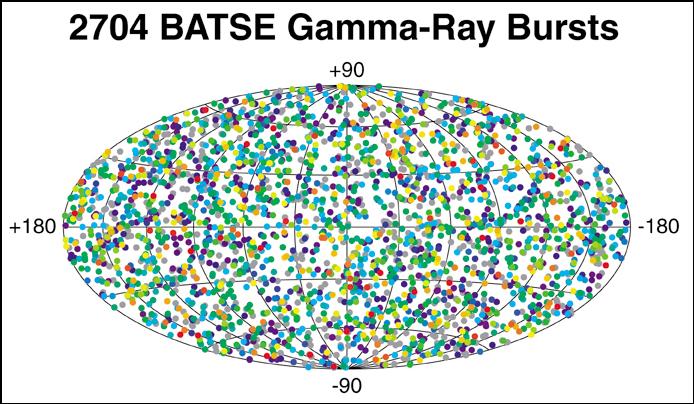
 Credit: NASA/CGRO Batse Team
Credit: NASA/CGRO Batse Team
The Bursting Universe
Surprisingly powerful explosions rock the Universe. These explosions can
be so powerful that the total brightness of the Universe varies by large
amounts over short times - by factors of two over days! Another surprise
is that these explosions are not rare - they occur a few times per week.
These incredibly large explosions are known as "gamma ray bursts", since
they were first discovered by Gamma ray satellites (space-based detectors
sensitive to gamma rays, the most energetic form of electromagnetic
radiation) more than 25 years ago. When these gamma-ray bursts were
discovered, it was thought by many scientists that they were nearby,
probably in our galaxy, since otherwise the amount of energy released would
be unbelievably large. The most detailed study of gamma ray bursts was
obtained by the Burst
and Transient Source Experiment (BATSE) on the Compton Gamma Ray Observatory
(CGRO). During its 9 year lifetime (1991-2000) BATSE detected more than
2700 gamma ray bursts. The image above shows the location of all these
bursts on the sky, color coded to show the brightness of the burst (the
brightest bursts are shown as red dots, the faintest as purple dots). A
startling result of the BATSE observations is that the bursts seem to be
distributed over the entire sky, indicating that the burst sources are not
associated with our galaxy. New
evidence suggests that gamma ray bursts are actually associated with
distant galaxies.
Last Week *
HEA Dictionary * Archive
* Search HEAPOW
* Education
Each week the HEASARC
brings you new, exciting and beautiful images from X-ray and Gamma ray
astronomy. Check back each week and be sure to check out the HEAPOW archive!
Page Author: Dr. Michael F.
Corcoran
Last modified January 22, 2001


